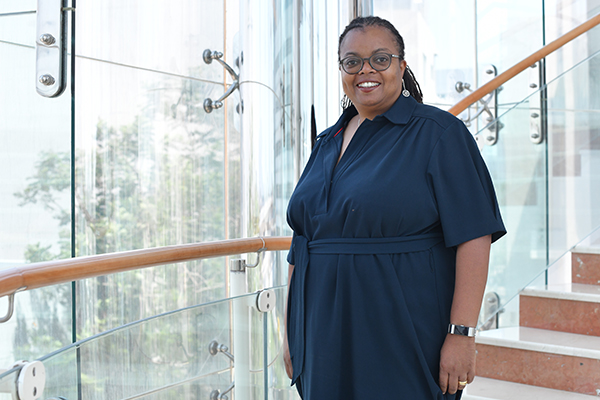Lack of exposure and incentive are major factors that contribute to unequal representation of women engineers in the broadcast field.
Pauline Hunter, Senior Manager, EPG Broadcast Management Systems at OSN, shares her insights on breaking into the industry with Rachel Dawson.
Women in the broadcast industry are under-represented. This can be traced to either not being given the same exposure as their male counterparts, or not being encouraged to pursue technical careers.
Compared to MENA, there are signs of positive change in the UK based on Ofcom’s 2018 Diversity and Equal Opportunities in Television report, which examined the representation of women across the five major broadcasters – the BBC, Channel 4, ITV, Sky and Viacom (which owns Channel 5) – in the UK and found that overall, women in the TV industry (46%) are represented broadly in line with the UK’s working population (47%).
While there is a small increase in women at senior levels, Sky employs fewer women (38%) as a proportion of its workforce than the other broadcasters. The proportion of women at senior management level across the industry has increased from 38% to 41%. Viacom and ITV have the highest proportion of women in senior management positions at 45%, while Sky has the lowest at 38%.
Men continue to dominate technology and engineering roles, with only 25% of these jobs held by women. Women are also under-represented to a lesser extent in creative and content production roles (43%). Still, these numbers are much higher in the UK than in MENA.
In the MENA region, women engineers in broadcast are a minority. We caught up with Pauline Hunter, Senior Manager, EPG Broadcast Management Systems at OSN, to learn more about her experience working in a male-dominated industry.
Undertaking the role of a broadcast systems engineer is an experience unlike any other, and because of its highly technical nature, most women don’t discover it, says Hunter. “It’s not one of those traditional jobs like a doctor or a lawyer, so I don’t think you’ll ever hear someone in school say they want to be in broadcast IT or broadcast engineering.”
She explains that only when more women are encouraged to undertake technical roles can the possibility of seeing a balance in the gender scale be realised.
“This is one of those fields you come across by accident, so what you find is people working on the business side who kind of fall into it. I’m from an IT background and ended up specialising in broadcast systems.”
Hunter works at OSN’s Broadcast Engineering department, where she looks after two distinct areas – the Channel Management/Broadcast Management systems and the Electronic Programme Guide (EPG), which she heads. She is also in charge of ensuring proper metadata for content.
“The CMS is used in many areas of the business, and it follows the life cycle of a programme from when we acquire it to when it is transmitted. So, effectively the planning and scheduling for linear and non-linear media are done via the CMS, and it interfaces with the media management systems and the EPG systems. So there’s a lot of interfaces that we need to look after from all the life cycle stages of that programme,” she explains.
“Once the content is acquired, it goes through the media workflow. All that information needs to be recorded in the system so people know the duration of a show, and then it needs to go through compliance checks. The planners and schedulers create an EPG for it and then they send a playlist of transmission for when it can be played out. We support the business from a technical point of view. We have to make sure that data is enriched to ensure greater content visibility and discoverability for the viewer.”
Of course, none of this is without its challenges, says Hunter.
“At OSN, the CMS hadn’t been upgraded for eight years, so effectively the upgrade meant scaling the system up 60 versions, and that was quite challenging. Together with my team, we managed this upgrade with no hiccups. From a customer-facing EPG perspective, the challenge is to ensure that the EPG for OSN’s 22 channels is correct, up-to-date and fresh. Our goal is to make sure the guide is informative; it tells them enough to pull them to the programme.”
Since the UAE country is so multicultural, it’s imperative for TV to reflect that in terms of serving audiences with a diverse slate of content and multilingual programmes, she says.
Hunter first dabbled in broadcast technology at Sky, where she was Head of Support of Broadcast Applications. She then worked at Fox Kids until it was acquired by Disney. Hunter spent approximately 12 years at Disney, where she oversaw the Broadcast systems for EMEA.
Hunter admits she never thought she’d be a broadcast engineer in college. Her education did not determine her venture into the broadcast industry.
“I studied Fuel and Energy at Leeds University. I wanted to be a reservoir engineer in 1989. When I finished my undergrad degree, I was working for the local authorities on energy projects. After that, I did something completely different and worked for a branch of the Chamber of Commerce. There I was helping women set up businesses, particularly from ethnic-minority backgrounds in the UK.”
Following this, jobs included a venture into medical software, where she was part of the Patients Not Paper campaign in the UK, a national service looking to reduce paperwork. She worked alongside a team that tried to build software that linked hospitals to doctors electronically. Then there was a change in government and the project came to a halt.
In 1997, Hunter bagged a role at Sky – “my first role in broadcast” – as Head of Support of Broadcast Applications, responsible for affiliate channels such as Fox Kids, National Geographic and Nickelodeon, all joint ventures at the time.
“This was my official introduction to the broadcast industry. Sky is an excellent place to work. It was innovative and in a lot of ways set the benchmarks in terms of their projects.”
Hunter eventually took a position at Fox Kids, later acquired by Disney, and stayed there for twelve years until she moved to OSN. She has worked with both large and medium-sized media corporations, and says both come with challenges and benefits. She describes a bigger conglomerate as a huge wheel that picks up pace as it moves.
“With bigger budgets, you get to do so much. The projects are bigger. But with OSN and Fox Kids, the challenge is to achieve what the mega guys are doing at the same time frames. I must admit these smaller companies manage to keep up, to find innovative ways to achieve the same without the bigger budgets. They become slicker to cut through the chase.”
Hunter has been at the helm of the Broadcast Engineering department for the last two years. Key achievements include several successful channel migrations.
“One major difference that I’ve witnessed with the pay-TV market in the Middle East, in comparison with Europe, is the importance given to TV ratings. In Europe, advertising and ratings are considered paramount to decision-making, whereas it doesn’t seem to be as much in the MENA region, mainly because it’s so difficult to aggregate those, and again because of the diversity – it’s very hard to pinpoint the trends in terms of what people are watching.”
She adds that the cost of data is still considerable here, and as a result people consume data very differently while they commute.
OSN itself has been a leader in implementing technologies whether it has to do with cloud, machine learning or AI and Hunter is part of a team that drives innovation in the network.
“I’m very interested in what other companies are doing and why they’re doing it. This is because eventually you want your company to be able to have an edge, and if you’re behind with technology, you can neither be the innovator nor can you be the first. That means you’re playing catch-up always. At OSN, we want to be at the forefront of technology, we believe that we lead. Therefore there’s been a lot of investment into technology, to ensure we don’t just keep up but set the trend. We’re working on our system to make it more efficient; our systems are sorted in terms of supporting the linear business, but the OTT, non-linear business also requires some attention so that we can support that team and have a better turnaround. You want your systems to be cleverer so that you’re just verifying what the systems can do.”
In keeping with OSN’s innovative streak, Hunter reveals that an AI component is in the offing. “We will hopefully be working with people who develop AI or bring that into practice. I’m looking at systems that employ AI components to take our OTT element forward.”
OSN is presently looking to consolidate its content offerings, making them cleaner for customers so that they can easily identify and choose the content they want to access.
“We’re constantly on the frontline of things, and I think that’s what I enjoy the most – to be able to innovate and create with the ever-changing trends of technology. That is the most rewarding aspect of my job,” she says, adding that OSN has played a key role.
“OSN tries to recruit the best person for the role, and by ensuring that, it ends up with diversity. When I look around, I see everyone from everywhere, men and women at all levels. I feel it looks for talent and makes sure that the right people are available for the roles.”
Hunter heads a team of seven women and two men, and is confident in her leadership.
“I try to lead by example and not just dictate terms. What you don’t want to be is a woman leader who tries to emulate men; you want to make sure that you’re capable of showing the attributes of being a woman, rather than pretending that you’re a male leader. I feel this is something women leaders do; they become very hard and that restricts diversity in leadership.
“I think everybody has a viewpoint, and I think you need to make sure you bring that feminine viewpoint to the role, because otherwise it’s not authentic. I think women have a bigger picture approach, we’re able to consider more. I find that men are more direct, they know what they want and why they want it. Women do the same, but they can consider more, and therefore compromise more, based on those considerations.”
















































































